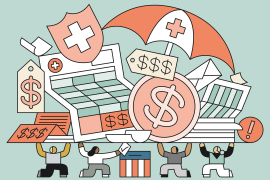Introduction
An estimated 26 million Americans, or 8 percent of the U.S. population, lacked health insurance in 2023.1 While the United States still lags countries that have universal coverage, today’s uninsured rate represents a sea change from the years prior to the Affordable Care Act (ACA), when twice as many people — 49 million, or 16 percent of the population — lacked health coverage.2 This was also a time when people with preexisting conditions were out of luck when they sought to buy insurance on their own, when millions of young adults became uninsured when they graduated from high school or college, and when insurance companies in the individual market charged young women much higher premiums than young men and rarely covered maternity care.
Congress and the Biden-Harris administration significantly strengthened the ACA with a temporary boost in premium subsidies for marketplace plans during the pandemic and then extended them in 2022. These subsidies, along with restored funding for outreach and enrollment following cutbacks during the Trump administration, led to a record 21 million people enrolling in marketplace plans in 2024.3 For households with low or moderate incomes, zero-premium or otherwise low-cost marketplace plans have been a source of affordable coverage for people who lost Medicaid when the pandemic-era continuous coverage protections ended. The extra subsidies also have allowed people in high-cost employer plans to access a more affordable coverage option.
Policymakers have more to do to protect the sweeping coverage gains of the past decade and build on these gains to bring comprehensive coverage to more people. The extended premium tax credits are set to expire at the end of 2025. If Congress fails to extend the enhanced tax credits, marketplace enrollees will experience an average premium increase of $705; 4 million more people are projected to become uninsured.4 Ten states still have not adopted the ACA’s Medicaid eligibility expansion, leaving 1.5 million of some of the poorest people in the country uninsured. And many Americans with insurance are still burdened by medical debt, medical billing errors, or denials of coverage.5
In the wake of an election that could fundamentally alter health care priorities, we present findings from the Commonwealth Fund Biennial Health Insurance Survey to describe the state of Americans’ health insurance coverage in 2024.6 We answer the following questions:
- How many people experience gaps in their coverage?
- How many people have insurance but are underinsured?
- Are health care costs affecting people’s decision to get needed care and is their health suffering as a result?
- How widespread is medical debt, and how much do people owe?
For the survey, SSRS interviewed a nationally representative sample of 8,201 adults age 19 and older between March 18 and June 24, 2024. This analysis focuses on 6,480 respondents ages 19–64; analysis of the 65-and-older population, most of whom have Medicare, will be published separately. Because of a new sampling method and online questionnaire introduced in 2022, in addition to changes to some key measures in 2024, we are unable to present data on trends in responses over the years. To learn more about our survey, including the revised sampling method, see “How We Conducted This Survey.”













